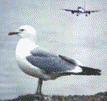Bird Strike Committee Proceedings

Bird Strike Committee-USA/Canada Joint Annual Meeting: 8th (2006)
Date of this Version
8-12-2006
Document Type
Article
Abstract
Is there a means by which birds might better discern aircraft position and speed, so as to reduce collisions? Vision is a primary and highly developed sensory pathway in birds, and recent work has shown that light can be an effective tool as a repellent and, potentially, as an alert. Given that bird-aircraft collisions (hereafter referred to as bird strikes) cost the commercial aviation industry world-wide in excess of $1.28 billion annually (U.S. $), the incorporation of ecologically salient light cues into the design of aircraftmounted lighting is one means by which airlines might reduce bird strikes. We will report current findings from a field trial involving an international airline company and 5 B737s monitored since 2004 relative to service hours, operational status of pulsed (0.75 Hz) vs. non-pulsed landing lights, and incidents of bird strikes. Importantly, this field trial involves aircraft in use commercially, seasonal aspects of routes and fluctuations in bird populations and activity, reports from the crews relative standard operating procedures, and reports of bird strikes. Data collected during 2004, prior to installation of a pulse-control system, indicate an average of 4 bird strikes per aircraft for the year. Following the same aircraft into 2005 and prior to installation of pulse-control systems, the test fleet experienced 3.2 strikes per aircraft. However, after installation of pulse-control systems, the airline reported an average of 2.2 bird strikes per aircraft when the pulse system was not in operation, and 1.0 bird strike per aircraft when the pulse system was in use. In addition to aspects of this field trial, we will review a series of on-going experiments, concurrent with the field trial, which involve the exploitation of avian response to light (wavelength, color, pulse frequency) and vehicle movement, our initial findings, and objectives of upcoming research.

